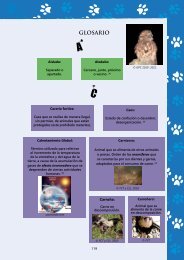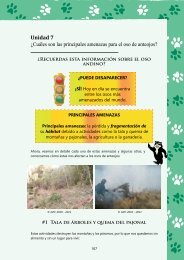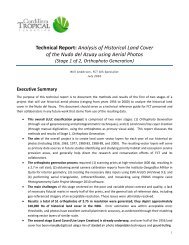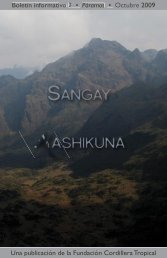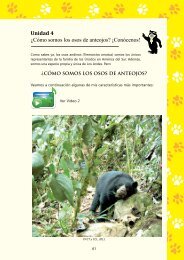monitoring and enforcing payment for ecosystem services programs
monitoring and enforcing payment for ecosystem services programs
monitoring and enforcing payment for ecosystem services programs
You also want an ePaper? Increase the reach of your titles
YUMPU automatically turns print PDFs into web optimized ePapers that Google loves.
This work was funded with the generous support of the American peoplethrough the Leader with Associates Cooperative AgreementNo.EPP-A-00-06-00014-00 <strong>for</strong> implementation of the TransLinks project.The contents of this report are the responsibility of the author <strong>and</strong> do notnecessarily reflect the views of the United States government.NO. 14; OCTOBER 2010M ONITORING AND E NFORCINGPAYMENT FOR E COSYSTEM S ERVICES P ROGRAMSL ESSONS L EARNEDAdrian Treves: University of Wisconsin-MadisonNelson Institute <strong>for</strong> Environmental Studies’ Carnivore Coexistence LabCatherine Schloegel: Fundación Cordillera TropicalPrivate l<strong>and</strong>owners <strong>and</strong> other community members should be rewarded <strong>for</strong>protecting <strong>ecosystem</strong> <strong>services</strong> <strong>and</strong> biodiversity locally. To be sustainable, suchincentive schemes must include training <strong>for</strong> community members to monitor <strong>and</strong>en<strong>for</strong>ce compliance. An ongoing project in Ecuador is developing cost-effective,long-term <strong>monitoring</strong> strategies <strong>for</strong> a program aimed at protecting large <strong>and</strong>endangered animals. This brief summarizes the lessons learned.♦♦♦♦♦♦♦♦SINCE 2006 FUNDACIÓN CordilleraTropical (FCT) has been developing aprogram to protect water <strong>and</strong> wildlife inthe Nudo del Azuay, southern SangayNational Park (SNP) in Ecuador. This<strong>payment</strong> <strong>for</strong> the protection ofenvironmental <strong>services</strong> (PPES) programrewards l<strong>and</strong>owners who protect tropicalmontane <strong>for</strong>ests from the upwardexpansion of the agricultural frontier <strong>and</strong>páramo grassl<strong>and</strong>s from increasedcultivation <strong>and</strong> road building.Like many protected areas in the tropics,the majority of SNP’s ostensibly publicl<strong>and</strong>s are also the property of farmers <strong>and</strong>indigenous communities with rights pre-datingthe park’s establishment. A successful incentiveprogram, there<strong>for</strong>e, must include closecollaboration among local property owners,regional <strong>and</strong> national actors, <strong>and</strong> continuous localengagement in all aspects of the process. Successalso requires a <strong>monitoring</strong> plan that helps ensurethat conservation is occurring on the privatel<strong>and</strong>s <strong>and</strong> protected areas involved. This briefoutlines the development <strong>and</strong> implementation ofa <strong>monitoring</strong> plan <strong>for</strong> the SNP PPES. The briefthen provides the lessons learned during thisprocess that have general applicable value <strong>for</strong>other incentive <strong>programs</strong> around the world.Lessons on <strong>monitoring</strong> <strong>and</strong> <strong>en<strong>for</strong>cing</strong> PES—1
How do we know it works?In 2009, FCT signed a cooperative agreementwith the Ecuadorian Ministry of Environmentto collaborate on the SocioBosque conservationincentive program. This program providesl<strong>and</strong>owners with an economic incentive toprotect areas of critical conservationimportance <strong>for</strong> the next 20 years. FCT assistslocal l<strong>and</strong>owners attempting to enter theprogram. This has included visits to homes,assistance with applications, <strong>and</strong>, mostsignificantly, helping create a high-qualitygeo-referenced map of the conservation area(examples of such a property map are availableupon request from FCT.) FCT expects to haveenrolled 12 l<strong>and</strong>owners <strong>and</strong> more than 500hectares of l<strong>and</strong> by the end of 2010.Long-term conservation of high montane <strong>for</strong>est<strong>and</strong> páramo <strong>ecosystem</strong>s requires rigorous<strong>monitoring</strong> to assure that endangered wildlifeis protected within participating properties <strong>and</strong>that the protected private properties <strong>for</strong>mcritical habitat conservation areas. TheCarnivore Coexistence Lab (CCL) of theNelson Institute <strong>for</strong> Environmental Studies atthe University of Wisconsin-Madison hasworked with FCT in developing cost-effective,long-term <strong>monitoring</strong> strategies <strong>for</strong> large <strong>and</strong>endangered mammals, such as the Andeanbear. For example, CCL students havedemonstrated the efficacy of using motionactivatedremote cameras to detect largebodiedvertebrates <strong>and</strong>, most recently, toidentify <strong>and</strong> monitor individual Andean bearspersisting on private <strong>and</strong> communal properties(see LTC Brief 13).CCL joined FCT to train communityparabiologists <strong>and</strong> train FCT field staff to usestate-of-the-art, field-tested methods tomonitor the endangered Andean bearpopulation across 96,000 hectares of privatel<strong>and</strong>s. Training included <strong>for</strong>mal workshops, acourse that addressed human-wildlife conflicts(see LTC Brief 7), <strong>and</strong> a field course on how toinstall <strong>and</strong> monitor infra-red activated, remotefield cameras. In<strong>for</strong>mal mentoring includestraining in project development <strong>and</strong>management, <strong>and</strong> guidance <strong>and</strong> oversight ofthe development of a scientifically robuststudy design.In developing <strong>and</strong> implementing the training<strong>and</strong> <strong>monitoring</strong> strategy, FCT <strong>and</strong> CCLconsidered the following methods integral to asuccessful program.Engage the community in <strong>monitoring</strong>. FCT<strong>and</strong> CCL began training local communitymembers as parabiologists, or communitymonitors. The target date to have them fullytrained is mid-2011. At that time, the parabiologistswill become park employees working asliaisons between their communities <strong>and</strong> theSNP. The parabiologists include representativesfrom seven mestizo <strong>and</strong> indigenous communitieswithin or near the park. Three are bilingualQuichua-Spanish speakers. The goal is toensure that local community members becomefuture leaders in national park management<strong>and</strong> biodiversity <strong>monitoring</strong>.Engage l<strong>and</strong>owners <strong>and</strong> the broadercommunity. We focused on betterunderst<strong>and</strong>ing l<strong>and</strong>owner tolerance <strong>and</strong>perceptions to threatening wildlife, <strong>and</strong> thenused these insights to guide interventions. Amonetary incentive, such as that provided bySocioBosque, may <strong>for</strong>m part of an effectivestrategy to protect wild l<strong>and</strong>s in southern SNP.However, monetary incentives are not likely tochange deeply held local perspectives aboutthreats posed by wildlife.Effective conservation must adequatelyrespond to the costs (both monetary <strong>and</strong> toquality of life) suffered by l<strong>and</strong>owners whoface wildlife threats to domestic animals <strong>and</strong>other property. We used short courses,community meetings, workshops, <strong>and</strong> smallgroupmeetings to share in<strong>for</strong>mation <strong>and</strong>transfer technical skills on how to respondeffectively to threatening wildlife.Lessons on <strong>monitoring</strong> <strong>and</strong> <strong>en<strong>for</strong>cing</strong> PES—2
Use the right tools <strong>and</strong> disseminate resultsto show that the methods work. Thecommunity parabiologists monitor biodiversityon private l<strong>and</strong>s within SNP using indirect signsurveys within <strong>for</strong>est <strong>and</strong> páramo, <strong>and</strong> remotecamera-traps located in <strong>for</strong>est. In 2010 CCLtransitioned from field testing <strong>monitoring</strong>methods <strong>and</strong> identifying endangered Andeanbears on private l<strong>and</strong>s to a training role.Training included teaching local communityparabiologists <strong>and</strong> FCT field staff site-specificEvidence of unique animals on private l<strong>and</strong>can lead to l<strong>and</strong>owners helping in ef<strong>for</strong>tsto protect wildlife.Photo by Becky Zug.<strong>and</strong> field-tested methods to monitor wildlife,particularly the Andean bear. We sharedknowledge <strong>and</strong> skills with a wide array ofaudiences: local organizations, universitystudents, members of the local press,international donors, <strong>and</strong> the general scientificcommunity. Most critically, the in<strong>for</strong>mationgenerated has been shared with participatingl<strong>and</strong>owners For example, sharing photos ofwildlife on a l<strong>and</strong>owner’s l<strong>and</strong> can create itsown incentive <strong>for</strong> that l<strong>and</strong>owner to conserve<strong>and</strong> protect wildlife.Lessons learnedWith the 10 community monitors trained in2009-2010, <strong>and</strong> a further 18 University deAzuay students <strong>and</strong> FCT staff trained by CCLin methods <strong>for</strong> underst<strong>and</strong>ing <strong>and</strong> managinghuman-wildlife conflicts, the work has yieldedseven lessons applicable to any conservationincentive program.Combine external technical knowledge withlocal expertise at every stage. Just as outsideexperts rarely underst<strong>and</strong> the local context <strong>and</strong>the feasibility of different methods <strong>for</strong> field<strong>monitoring</strong>, local experts require technicalinput from an outside perspective. Thissynergy should exist not only at the training<strong>and</strong> design phases of a project but throughoutto assure the high quality of <strong>monitoring</strong> data,continued sociopolitical acceptance <strong>and</strong>feasibility of the field activities, <strong>and</strong> effectivedissemination of methods <strong>and</strong> results locally,regionally, nationally, <strong>and</strong> internationally.CCL <strong>and</strong> FCT achieved this continuouscomplementary mix of expertise as follows.CCL brought lessons, methods, equipment,<strong>and</strong> funding from several disciplines <strong>and</strong>countries via quarterly, intensive training <strong>and</strong>planning visits. FCT supported a pair oftrained biologists to transfer knowledge tocommunity monitors, contributed funding fromseveral international <strong>and</strong> national sources, <strong>and</strong>provided weekly administrative, financial, <strong>and</strong>personnel oversight. Local communitymonitors (parabiologists) contributed theirknowledge of the people, wildlife, <strong>and</strong>l<strong>and</strong>scape in continuous surveillance <strong>and</strong>bimonthly, systematic surveys of theirpredetermined patrol routes.Build teamwork among communitymonitors. The nature of the patrol work inremote areas with little interaction among teammembers necessitates focused team building.Community monitors patrol in teams of two,covering more than 70,000 hectares.Community monitors use field notebooks <strong>and</strong>GPS units to maintain high-quality records ofLessons on <strong>monitoring</strong> <strong>and</strong> <strong>en<strong>for</strong>cing</strong> PES—3
wildlife signs (see Figure 1). Each communitymonitor pair works in a unique <strong>and</strong> remotefield location with little interaction among thedifferent crews. As such, weekly meetingsbetween park guards <strong>and</strong> FCT staff facilitatecommunication, rapid response to equipmentproblems, <strong>and</strong> collaborative problem-solving.Train community monitors in skills theymay need in the field <strong>and</strong> the office. Ideallycommunity monitors will go on to careers in<strong>monitoring</strong> PES <strong>programs</strong> <strong>and</strong> possibly train orsupervise others per<strong>for</strong>ming such tasks.There<strong>for</strong>e community monitors must be seenas the long-term capacity of the community toperpetuate <strong>monitoring</strong>. FCT training of thecommunity monitors has included:• 13,520 hours of patrol in four subwatersheds(see Figure 1)• 3,520 hours of training <strong>and</strong> capacitybuilding via <strong>for</strong>mal workshops onhydrological <strong>monitoring</strong>, herpetofauna <strong>and</strong>large mammal identification, <strong>and</strong> skillbasedtraining on the use of scientificequipment, professional skills, <strong>and</strong>management of a microenterprise.Figure 1. Eleven months of patrolling shown by GPS locations taken by ten community park guards within SangayNational Park. Ecuador.Lessons on <strong>monitoring</strong> <strong>and</strong> <strong>en<strong>for</strong>cing</strong> PES—4
• 80 hours of environmental education in localschools• 64 hours of patrol <strong>for</strong> illegal fishing in theDudas sub-watershed• weekly meetings to provide ongoing trainingin field-based biology <strong>and</strong> <strong>monitoring</strong>skills, including the use of GlobalPositioning Systems (GPS), photographyusing point-<strong>and</strong>-shoot digital cameras,computing skills including data <strong>and</strong> photodownload, word-processing, leadership, <strong>and</strong>environmental education.Maintain the links between communitymonitors <strong>and</strong> their home communities,especially participating l<strong>and</strong>owners. Thecommunity monitors serve continuously asambassadors <strong>for</strong> the project, the PPESprogram, <strong>and</strong> the communities they represent.Although FCT/CCL-trained communitymonitors have little <strong>for</strong>mal education (mosthave completed school through 6 th grade), theyhave far exceeded expectations by serving asliaisons between the park <strong>and</strong> communities,providing on-site education about the park toresidents, school children, <strong>and</strong> visitors, <strong>and</strong>demonstrating keen interest in research <strong>and</strong><strong>monitoring</strong> projects.In May 2010, CCL <strong>and</strong> FCT designed <strong>and</strong> leda two-week short course entitled “Balancinghuman needs <strong>and</strong> carnivore conservation” <strong>for</strong>15 undergraduates from the University ofAzuay in Cuenca, Ecuador (co-financed by theFulbright Senior Specialist Program). Anovernight field excursion allowed participantsto learn camera-trapping techniques in situ <strong>and</strong>enhance their underst<strong>and</strong>ing of bear attacks onlivestock via interviews with local l<strong>and</strong>owners.In August 2010, FCT began trainingl<strong>and</strong>owners <strong>and</strong> their families how to design,install, <strong>and</strong> maintain deterrents <strong>and</strong> preventivemeasures against bear attacks on dairy cattle.Reach beyond the project area to learncontinuously <strong>and</strong> share lessons widely. Aproject team must learn to make mid-coursecorrections, add new insights to improveefficiency <strong>and</strong> solutions, <strong>and</strong> anticipateproblems. In our project, FCT providesguidance <strong>and</strong> training to colleagues at nearbyCajas National Park in the Azuay Province,renowned bear expert Arm<strong>and</strong>o Castellaños atFundación Espiritu del Bosque in Ecuador, <strong>and</strong>the Ecuadorian Ministry of Environment. Thework is further disseminated to the regionalwater fund, FONAPA, which is developing awatershed-level biodiversity <strong>and</strong> hydrological<strong>monitoring</strong> plan. CCL has reported on projectgoals <strong>and</strong> methods to colleagues in Ecuador<strong>and</strong> beyond with dozens of public talks <strong>and</strong>publications (<strong>for</strong> examples, see http://www.nelson.wisc.edu/people/treves/Publications.html).This outreach has included the WildlifeConservation Society-Ecuador, ConservationInternational-Ecuador, <strong>and</strong> the EcuadorianMinistry of the Environment.Combine social scientific <strong>monitoring</strong> withbiodiversity <strong>monitoring</strong> to ensure on-thegroundconservation results. CCL issupporting FCT in social scientific research onl<strong>and</strong>owners’ changing attitudes to biodiversity,management interventions, incentive schemes,<strong>and</strong> reprisals against wildlife. The surveys areintended to provide a baseline by which tomeasure changes in perception <strong>and</strong> attitudeover the life of the project. CCL also is testingnew methods <strong>for</strong> non-invasive <strong>monitoring</strong> ofendangered vertebrates. Our partnershipcreates an exceptional opportunity to traincommunity monitors to underst<strong>and</strong> <strong>and</strong>deploy advanced <strong>monitoring</strong> equipment,such as remotely triggered camera traps, <strong>and</strong>field devices <strong>for</strong> the passive collection of hair<strong>for</strong> DNA.PES schemes must reliably deliver economicincentives to private l<strong>and</strong>owners.When SocioBosque approached FCT with aproposal to work together, this helped createlong-term stability with the promise that theMinistry of Environment will provide funding<strong>for</strong> the duration of 20-year conservationcontracts. However, there have been problemsdelivering incentives.Lessons on <strong>monitoring</strong> <strong>and</strong> <strong>en<strong>for</strong>cing</strong> PES—5
FCT pre-enrolled 3000 hectares owned by 140beneficiaries on 39 parcels to participate in theSocioBosque program. As of May 2010 (theend of the most recent enrollment period),SocioBosque accepted just two areal<strong>and</strong>owners to participate in the program.Large-scale participation in the SocioBosqueprogram has been inhibited by a myriad ofissues. For example, initially SocioBosquefocused solely on <strong>for</strong>est conservation,excluding other <strong>ecosystem</strong>s. However, in June2009, the Ministry of Environment exp<strong>and</strong>edthe program first to include páramos <strong>and</strong> then,in March 2010, l<strong>and</strong>owners within protectedareas. Nevertheless, program designers haveyet to accept the majority of l<strong>and</strong>owners in theSNP region because they lack a geo-referencedmap of the property <strong>and</strong> reference to the totaltitled area (in hectares).Furthermore, SocioBosque must resolve theincompatibility between regional <strong>and</strong> nationall<strong>and</strong> titling agencies. A poorly organizeddecentralization of l<strong>and</strong> titling to provincialleaders led each of the 24 provinces to titlel<strong>and</strong> in a distinct manner. Ultimately, someprovinces’ l<strong>and</strong> titles remain unrecognized bythe regional capital.The short-term result is that the SocioBosqueprogram continues to value overall number ofhectares enrolled without necessarily creatingcontiguous conservation blocks linkingnational parks with their buffer zones orimportant habitat <strong>for</strong> wide-ranging wildlife.Similarly, a lack of direct benefits has slowed theacceptance of a private, eco-label scheme,Wildlife Friendly Certified. To date, only AllThings Alpaca has been certified in the projectarea. No other property owners have developedvalue-added local products that could potentiallyapply <strong>for</strong> Wildlife Friendly certification.The critical lesson is that when PES fundsdon’t flow, other incentives must be providedin the interim. While FCT itself cannot paypre-enrolled l<strong>and</strong>owners, it is able to helpl<strong>and</strong>owners mitigate the costs of livingalongside damaging wildlife. FCT <strong>and</strong> CCLsponsored a workshop that brought together 52private l<strong>and</strong>owners to discuss property damageby wildlife <strong>and</strong> non-lethal interventions tomitigate those losses. Five of those l<strong>and</strong>ownersare working with FCT to plan <strong>and</strong> implementnon-lethal deterrents, which will prevent theendangered Andean bear from attacking dairycattle on remote pastures. While PES funds areslow in flowing to participating l<strong>and</strong>owners,this local collaboration promises to offset costsof conservation <strong>for</strong> environmentallyconcernedl<strong>and</strong>owners.♦♦♦♦♦♦♦♦Published by the L<strong>and</strong> Tenure Center. Comments encouraged:L<strong>and</strong> Tenure Center, Nelson Institute of Environmental Studies,University of Wisconsin, Madison, WI 53706 USAkdbrown@wisc.edu; tel: +608-262-8029; fax: +608-262-0014http://www.ies.wisc.edu/ltcLessons on <strong>monitoring</strong> <strong>and</strong> <strong>en<strong>for</strong>cing</strong> PES—6



